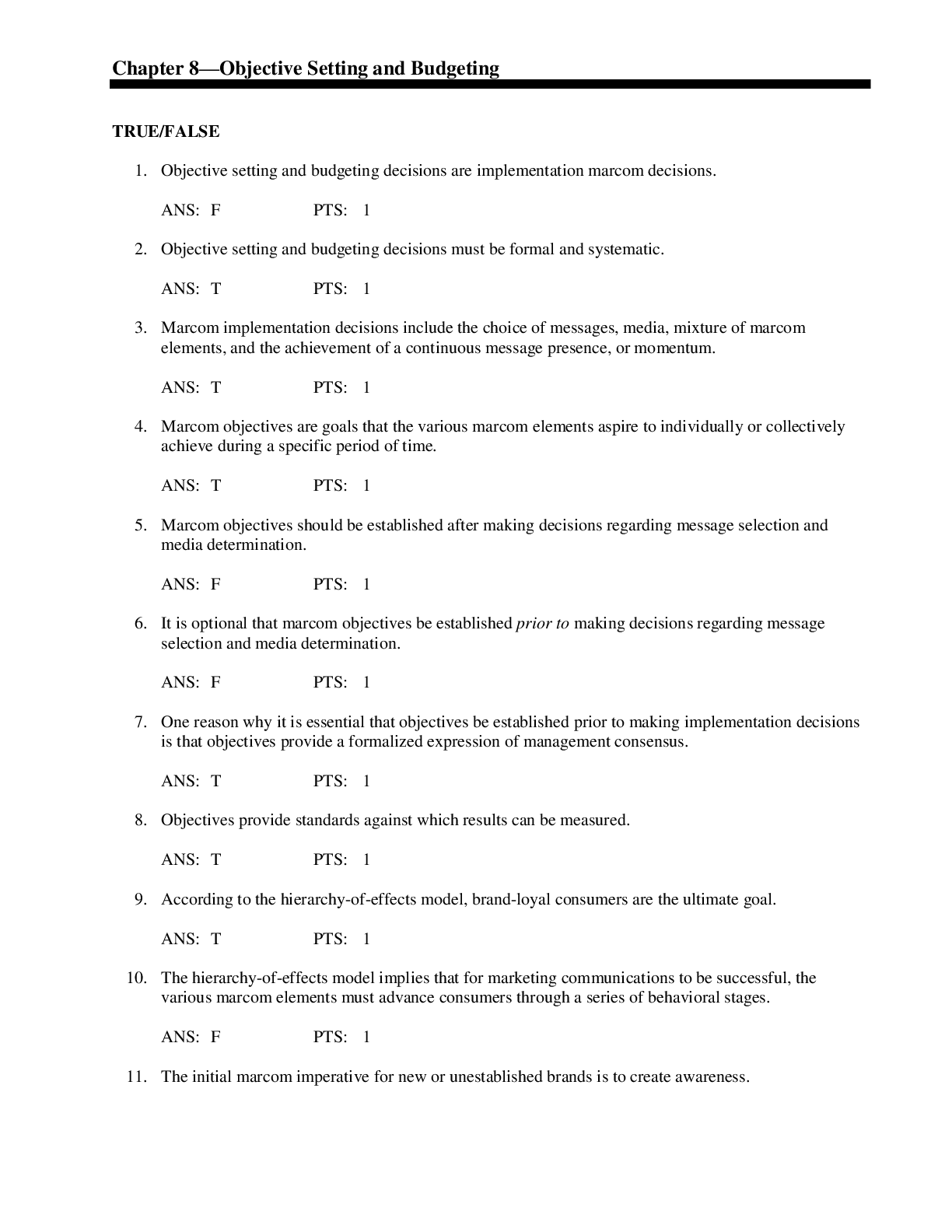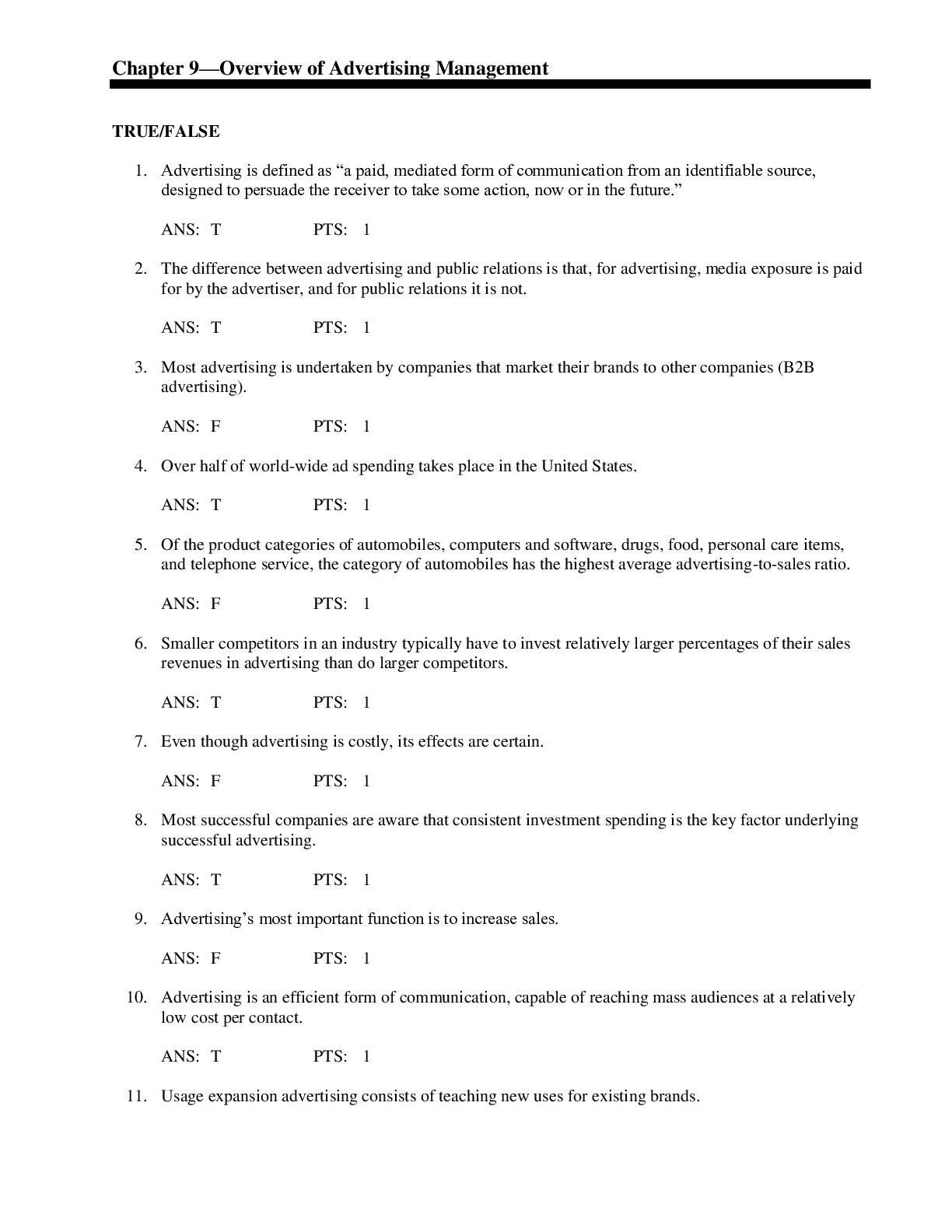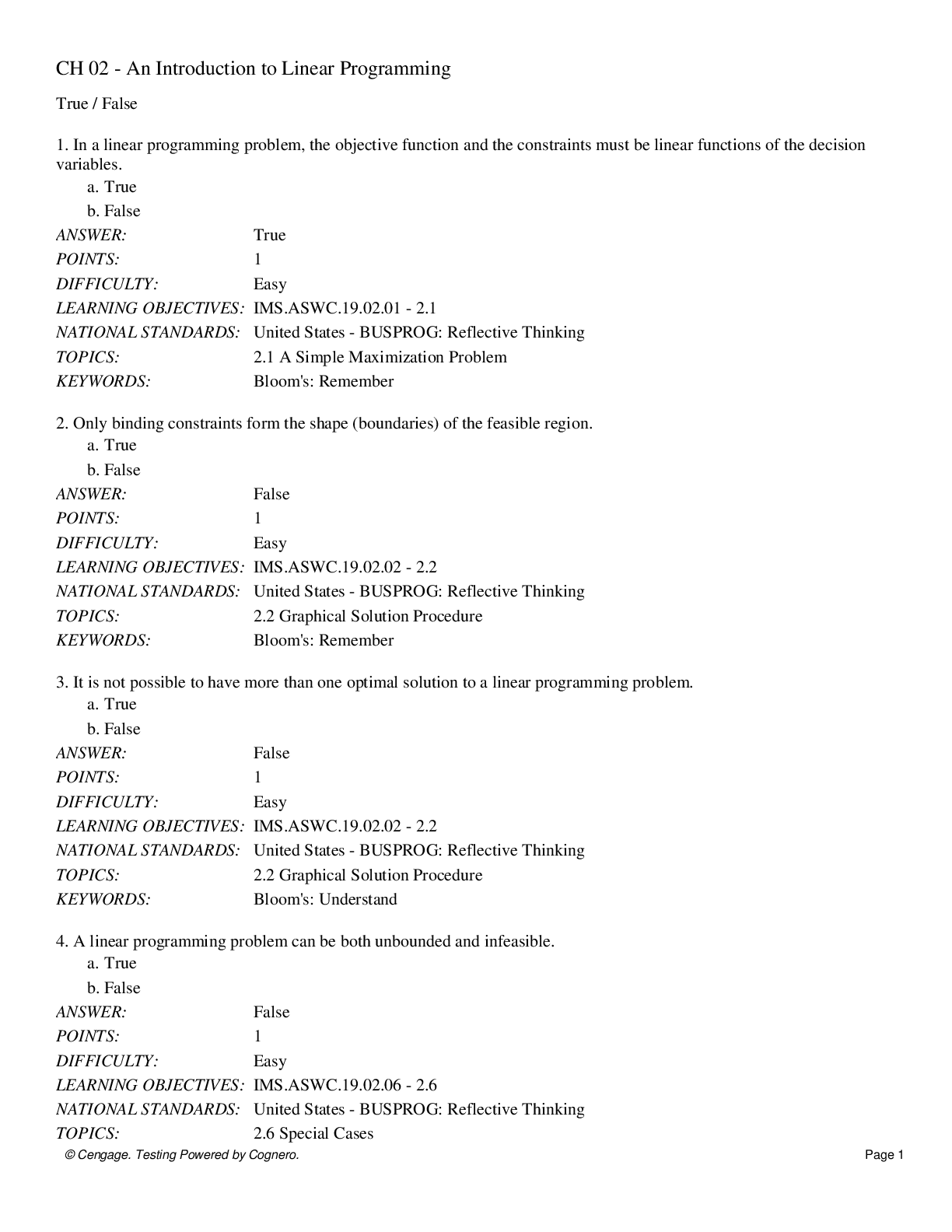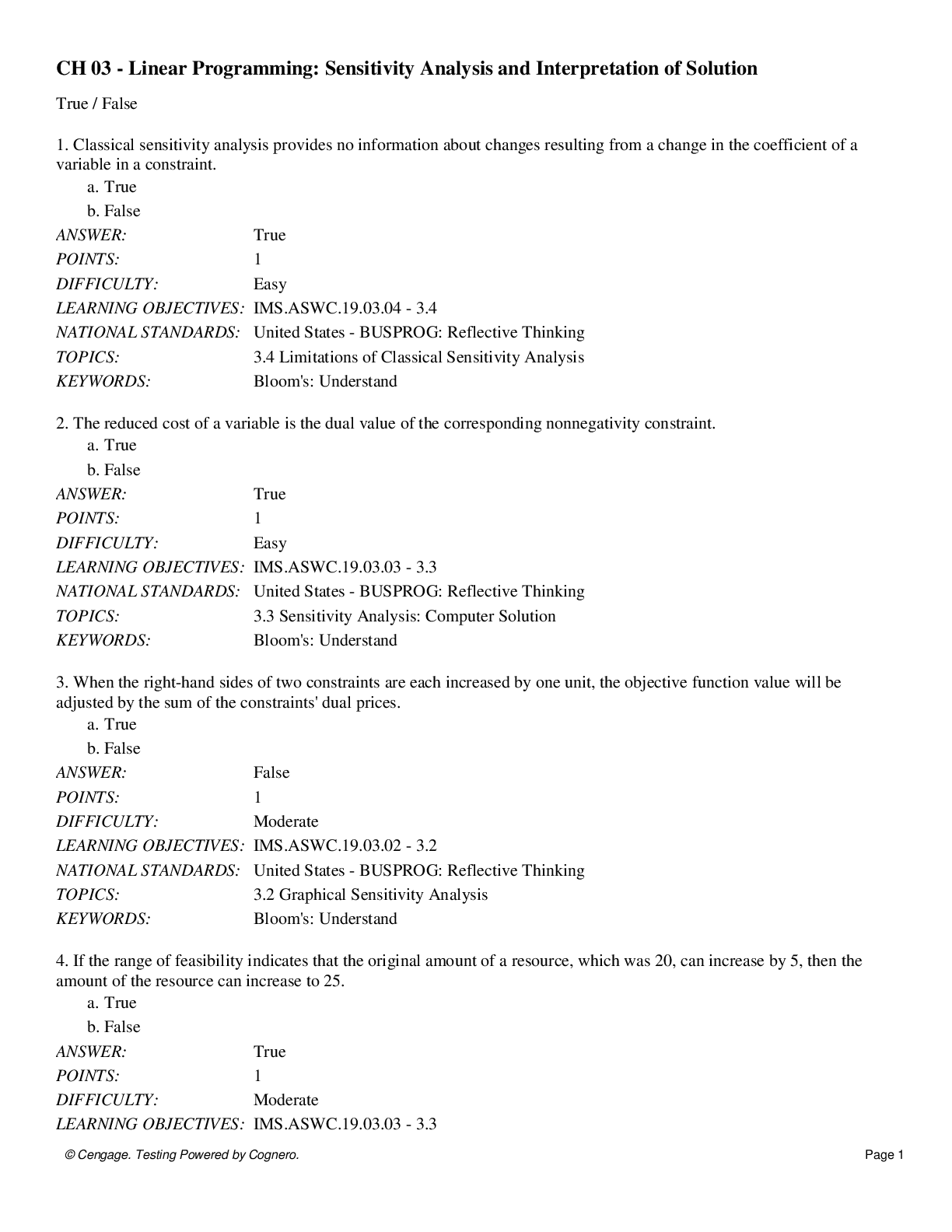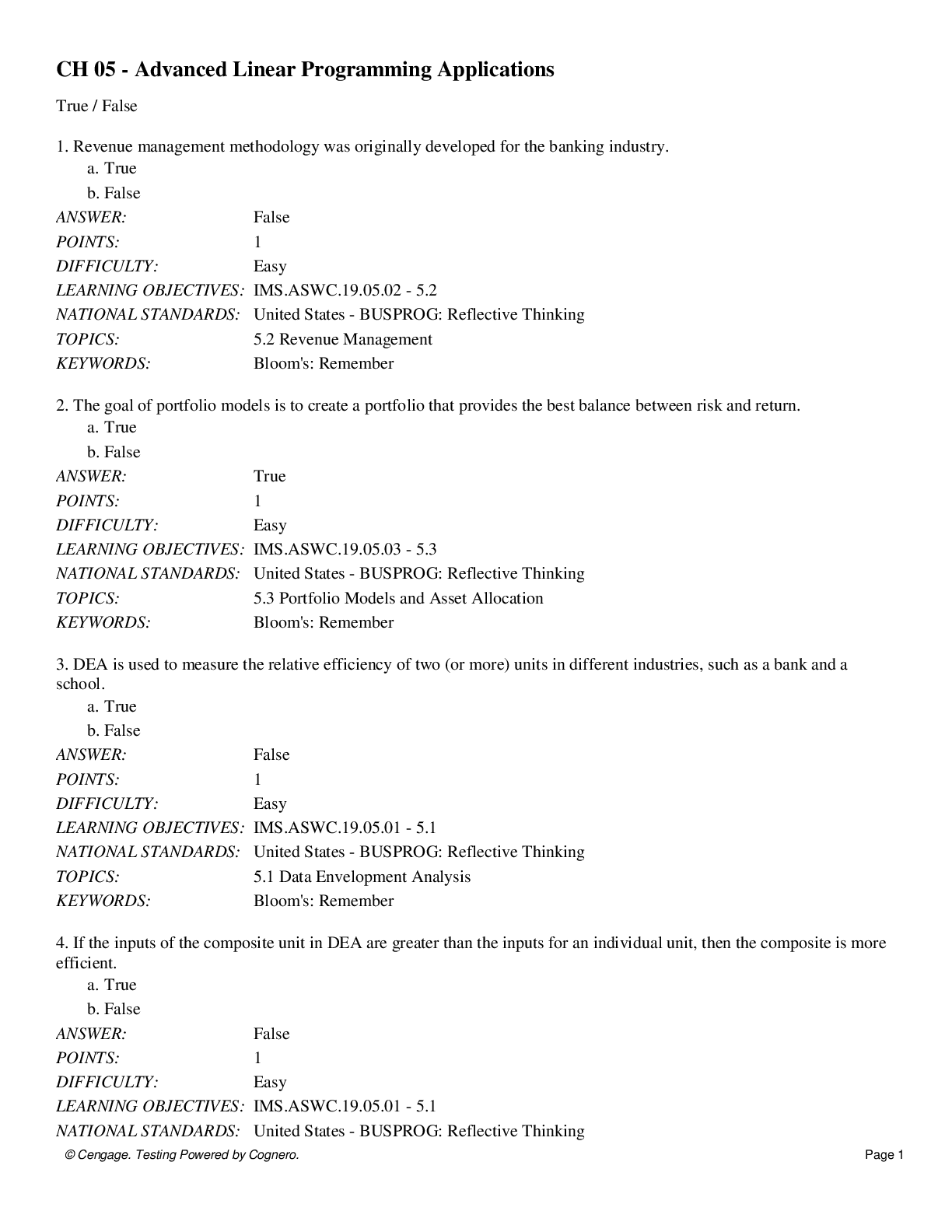Education > QUESTIONS & ANSWERS > CT Foundations of Reading Test Questions and Answers 100% Pass (All)
CT Foundations of Reading Test Questions and Answers 100% Pass
Document Content and Description Below
CT Foundations of Reading Test Questions and Answers 100% Pass Phonological Awareness (2 parts) ✔✔Phonemic Awareness and Phonics HIM (Phonemic Awareness) stands for? ✔✔Hear, Identify, Manip... ulate Phonemic Awareness can be done in the ________. ✔✔Dark Phonics is the second you introduce ______. ✔✔Print Levels of Phonemic Awareness ✔✔OBACSS O=Onset/Rime B=phoneme blending A=phoneme approximation C=phoneme counting Se=phoneme segmentation Su=phoneme substitution Mantra for ELL student ✔✔Find out what he/she knows and then teach what he/she DOESN'T know. Concepts of Print (8) ✔✔Print Awareness One-One Correspondence Directionality Letters,words and sentences Upper and Lowercase Parts of a book First and Last Beginning, Middle and End Phonemic Awareness - Onset/Rime ✔✔Separating the first part of the word from the rest of the word. Ex: /st/ onset and /ick/ rime. Stick. Phonemic Awareness - Phoneme Blending ✔✔Blending individual sounds to form a word. Ex: /s/, /i/, /t/ makes "sit". Phonemic Awareness - Phoneme Approximation ✔✔Identifying where a given sound is heard in a word. Ex: Where is the /s/ in "sat"? Phonemic Awareness - Phoneme Counting ✔✔Counting the number of phonemes in a word. Ex: How many sounds are in bread? (4) Phonemic Awareness - Phoneme Substitution ✔✔Highest level - child substitutes a sound at the beginning, middle and end of a word. If you know "sat" then you know "mat". Concepts of Print - Print Awareness ✔✔child understands that print carries a message Concepts of Print - One to One Correspondence ✔✔child recognizes a match between each word read and each word printed as text on a page Concepts of Print - Directionality ✔✔child holds book correctly and "reads" from left to right and top to bottom. (tracking) Concepts of Print - Letters, words and sentences ✔✔child recognizes and distinguishes between letters, words and sentences Concepts of Print - Upper and Lowercase ✔✔child recognizes and distinguishes between upper and lowercase letters and punctuation. Concepts of Print - Parts of a book ✔✔child recognizes author, title, and front/back of book. Concepts of Print - First and last ✔✔child has knowledge of first and last Concepts of Print - Beginning, middle and End ✔✔part of book handling skills Alphabetic Principle ✔✔Assumption that each sound is represented by a grapheme or letter. How many sounds in the alphabet? ✔✔44 Instructional sequence for Word Study ✔✔Single Consonant Sounds Consonant Clusters (bl, gr, and sp) Consonant Digraphs (sh, ch and th) Short Vowels Long Vowels Vowel Teams (digraphs and dipthongs) What are the 2 approaches to teaching phonics? ✔✔Explicit and implicit. Explicit approach to phonics is ___________. ✔✔Direct instruction (synthetic or sound by sound). This is done first before Implicit (reinforcing) Implicit approach to phonics is _________. ✔✔Is used after Direct Instruction to reinforce skill taught. It is analytic (embedded). What are the 6 syllable types? ✔✔COVERS Closed Open Vowel Team Silent E R Controlled Final Stable syllable What is a closed syllable? ✔✔VC - short vowel sound. Syllable is "closed" in by a consonant. Ex: at, but, van, mat, ham What is a open syllable? ✔✔V - long vowel sound. Syllable is not closed in by a consonant. Ex: he, we, hi What is a vowel team syllable? ✔✔V V - digraphs and dipthongs. Ex: rain, boat, cow, haul. What is a r-controlled syllable? ✔✔Vr - vowel sound controlled by r. Ex: for, car, fir, her What is a silent e syllable? ✔✔Vce - e makes the vowel long. Ex: ate, bite, white What is a final stable syllable? ✔✔Cle, le, tion. Ex: crumble, action What is a homophone? ✔✔Words that sound the same, but have different spellings and different meanings. Ex: sea, sea What is a homograph? ✔✔Words that are spelled the same but have different meanings. Ex: bank. I keep my money in the bank. The house is on the bank of the river. What are the 3 cueing systems? ✔✔Syntactic Cueing, Semantic Cueing, Graphophonic Cueing What is Syntactic Cueing? ✔✔(grammar/structure). Structure of our language. Does it sound right? What is Semantic Cueing? ✔✔(meaning/context). Refers to the type of context clue that helps aid in word recognition. Part of speech, the position or function of the word. Does it make sense? What is Graphophonic Cueing? ✔✔(phonics/visual) relates to the letter sound or spelling patterns./ Does it look right? What are Semantic Maps? ✔✔Allows students to conceptually explore their knowledge of a new word by mapping it with other related words or phrases. Semantic refers to the relationships between and among words. What is Receptive Language? ✔✔the words you understand when listening to other people. What is Expressive Language? ✔✔the words that you understand when you talk and write. Smaller than your receptive vocabulary. Five common Text Structures for Informational Text: ✔✔Description - details to form images. Sequence - Events in the order they happen. Comparison/Contrast - Discuss 2 ideas/events Cause/Effect - Provide explanation Problem/Solution - Identify problem and solution. What are the 3 tiers of vocabulary? ✔✔Tier 1 - basic words - rarely require instruction. Tier 2 - High Frequency words - mature language users. Found across a variety of domains. Tier 3 - Low-frequency words - content-specific words. Learning of a new word involves several levels of knowledge: ✔✔Unknown word - "I don't know the word." Initial Recognition - "I have seen/heard the word but don't know what it means." Partial Word Knowledge - "I know one meaning, but cannot use it in my writing." Full Word Knowledge - "I know more than one meaning and can use it in my writing." Structural Analysis ✔✔Decoding of Multisyllable words Comprehension definition ✔✔The process of constructing meaning using both the author's text and the reader's background knowledge. Readers interact with the text in the process of constructing meaning. Literary Device - Allusion ✔✔A reference to a historical or literary figure or event Literary Device - Expository Text ✔✔Non-fiction, informational or factual text. Literary Device - Irony/Satire ✔✔Writer says the opposite of what he means. Authentic Assessment ✔✔based on student reading and writing (portfolio) Norm-Referenced ✔✔AKA standardized test (high-stakes). Students are COMPARED to a sample group. Stanford-Binet, Woodcock Reading Mastery Test. Norm-Referenced - scaled scores ✔✔Continuous ranking from 1-999. Used to track long-term growth. Basis for converting scores to percentiles, stanines and grade equivalents. Norm-referenced -2 forms of scaled scores ✔✔Degrees of Reading Power (DRP) Lexile Framework Norm-referenced - Raw score ✔✔total number correct on an assessment. Norm-referenced - Percentile rank ✔✔ranking of percentages from 1-99 that a score is equal to. Norm-referenced - Stanine ✔✔a ranking of 1-9 for which a percentile is converted Norm-referenced - Grade Equivalent ✔✔grade and month which the standard score converts. Criterion-referenced ✔✔AKA informal assessments. Students are compared with a criterion or standard. Benchmarks are used. DRA, F&P, IRI Criterion-referenced - IRI ✔✔Informal Reading Inventory - series of reading passages that become more difficult. Much info on reading comprehension, phonics etc. Criterion-referenced - IRI 2 parts ✔✔graded word lists graduated reading passages IRI - levels ✔✔Independent 96-99% Instructional 94-95% Frustration 90% and less IRI Listening Comprehension ✔✔70% or better Reliability ✔✔measure of consistency. If given over and over, will it yield the same results? Validity ✔✔Does the test measure what it is supposed to? Construct Validity ✔✔is the extent to which a test measures a particular aspect of reading. Content Validity ✔✔is the extent to which the assessment aligns with the actual tasks that students are taught in the classroom. Correlation Coefficient ✔✔high score = .80 low score = .45 Standard Error of Measurement ✔✔Statistical approximation of how much a test may vary if given over and over. Retelling Rubric SCPIST ✔✔Setting Characters Problem Important Events Solution Theme Shared Reading ✔✔Usually with Big Books. Book is read many times over several days. Running record terms ✔✔Analysis of word structure Structural analysis (multisyllable words) Context Clues (semantic, syntactic, graphophonic) Identification of sight words [Show More]
Last updated: 1 year ago
Preview 1 out of 13 pages
Instant download
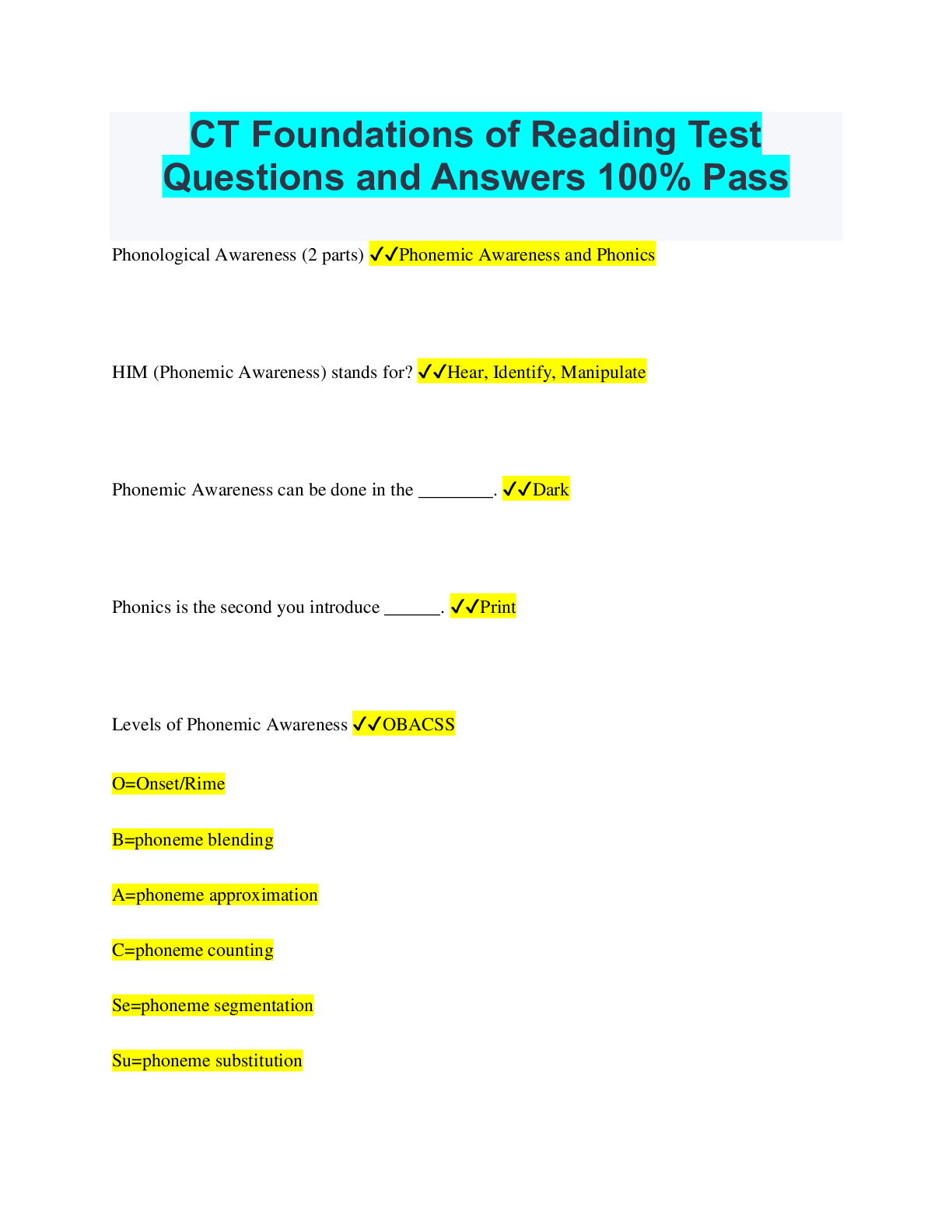
Buy this document to get the full access instantly
Instant Download Access after purchase
Add to cartInstant download
Also available in bundle (1)

Foundations of Reading Bundled Exams Questions and Answers Already Passed
Foundations of Reading Bundled Exams Questions and Answers Already Passed
By Nutmegs 1 year ago
$24.5
18
Reviews( 0 )
Document information
Connected school, study & course
About the document
Uploaded On
Apr 18, 2023
Number of pages
13
Written in
Additional information
This document has been written for:
Uploaded
Apr 18, 2023
Downloads
0
Views
73

.png)
.png)
.png)
.png)
.png)
.png)
.png)
.png)
.png)
.png)
.png)





